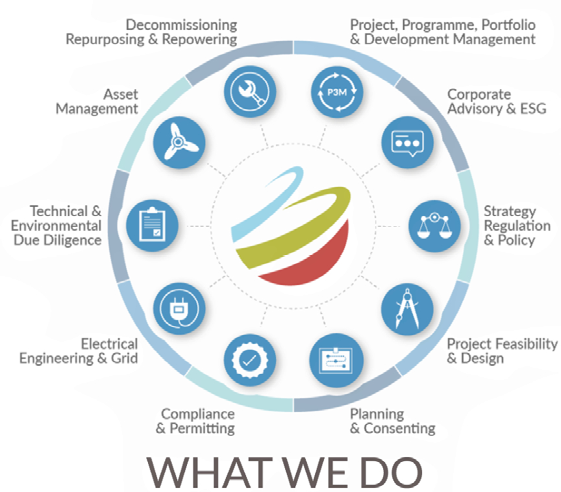
Ruth Fain
In this article, Ruth Fain at environmental consultancy, ITPEnergised, explores the critical role of environmental assessments in the licensing of space flight activities, with particular reference to her own experience of preparing licensing documentation for the UK regulator.
From Nasa’s Artemis 1 mission to satellites that can create a 3D map of the globe’s forests to help assess the impact of deforestation on climate change — space launches continue to be big news.

As the world works to address the climate crisis and reduce its carbon emissions to net zero over the coming decades, the successful licensing of space flight activities will play a critical role in enabling the huge potential that satellites
and the space sector bring to modern society, whilst ensuring that adverse environmental impacts associated with the sector are minimized.
Currently, only 10 countries have their own launch capabilities and, as yet, there is no global standard for the environmental assessment and regulation of space flight activities, although countries such as the US and UK have implemented their own national regulations.

In the US, the Federal Aviation Administration (FAA) is the regulator for Commercial Space Transportation Activities — having licensed more than 370 launches (excluding some NASA or Department of Defense launches). An evaluation by the FAA includes an assessment of public safety issues, national security or foreign policy concerns, insurance requirements for the Launch Operator, as well as an assessment of its potential environmental impact. The FAA is also the regulator for spaceports and can issue experimental permits, rather than licenses, for the launch or re-entry of reusable suborbital rockets.
In the UK, the equivalent regulator is the Civil Aviation Authority (CAA) and any organization looking to operate a spaceport or launch vehicles from the UK is required to undertake an assessment of environmental effects (AEE). From my experience of this new process, it is clear that the UK Government, through the CAA, is committed to setting a very high bar for environmental protection, while supporting the growth of a robust and competitive commercial space sector.
What An AEE Involves
An AEE must consider the impact of space operations on human populations and health, the marine environment, land, soils and peat, landscape and visual impact and material assets (cultural heritage), biodiversity, air and water quality, as well as noise and vibration.
In the UK, AEEs follow a similar process to that of environmental impact assessments, required under UK planning regulations. However, there are certain key differences, including the scope and methods used in formulating AEEs. It is also important to note that there are unique considerations relating to AEEs for spaceports and Launch Operators.
Collaboration Key To Environmentally Secure Operation
Co-operation between the spaceport and Launch Operator is key to the ethosof the UK’s regulations, which aims for all parties to work together to ensure the safest and most environmentally secure operation.
When producing an AEE, unless a spaceport is to have only one Launch Operator, such as with Spaceport Cornwall and Virgin Orbit, it is unlikely that a joint AEE between the spaceport and Launch Operator will be appropriate.
A Launch Operator that wishes to use a spaceport accessed by multiple operators will be required to have its own individual AEE completed, in addition to the spaceport’s own AEE documentation. There may well be overlap between the two documents, but each should be able to stand alone as a full assessment.
For a spaceport AEE, the operator will need to engage with their potential partners to determine the likely scale, fuel type and physical formats of proposed launch vehicles, their anticipated trajectories and maximum number of launches, in order to assess the environmental impact of their future operations using a precautionary approach.
Where there has been this early collaboration, it may then be that the spaceport will enable the Launch Operators to access the spaceports’ own assessments
at the point where the Launch Operator is creating its own AEE. This reduces duplication of efforts and aids in the refinement of assessments based on a specific launch vehicle and operator, ensuring greater accuracy.
International Expertise May Be Key To Successful AEE Submission
ITPEnergised has submitted two AEEs to the UK’s Civil Aviation Authority for consideration, one for SaxaVord UK Spaceport in Shetland, and the other for Skyrora Limited, a Launch Operator. ITPEnergised is currently assisting several other Launch Operators with the preparation of their AEEs.
The physical mechanics of a rocket launch involve a high level of complexity when it comes to assessing its impact on air quality and noise levels, and dependent on the location of the launch and its trajectory, it may be that additional modeling is required to assess the effects of sonic booms and marine chemistry interactions.
With no previous assessments to work from, ITPEnergised has developed an expert team comprised of impact assessment practitioners based both in the UK and the USA (particularly for noise and sonic boom assessment as undertaken for NASA and the ESA).
As with any new industry, the lack of datasets to support AEEs poses a significant constraint. When completing the AEE for Saxavord UK Spaceport, it was necessary to draw on surveys and datasets from other countries, particularly regarding noise and ecological effects.
Due to this lack of data, and despite there being no significant effects predicted for the operation of the spaceport, SaxaVord is looking to undertake noise and ecological monitoring during a range of launches to help develop a working database that they and the regulator can access and use in the future.
While there remains limited, world-wide consensus on the environmental assessments required for space flight activities, it is clear that the UK is setting a high standard for its own assessment of environmental effects; looking to ensure that the nation becomes a global benchmark for sustainable management of sub-orbital and orbital launches in this decade and into the future.
www.itpenergised.com


